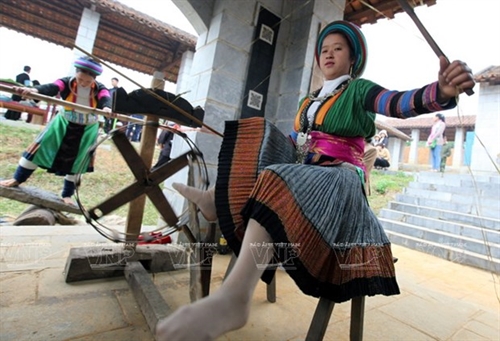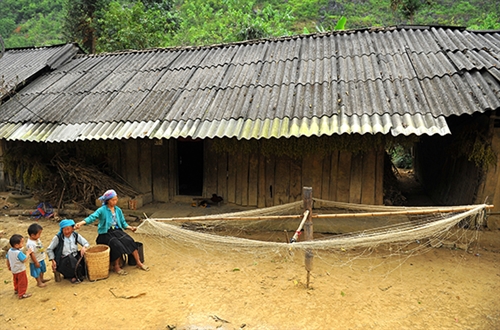The Hmong, a Hmong-Dao ethnic group with a population of more than 1.39 million, formed six subgroups, namely Hmong Hoa, Hmong Xanh, Hmong Trang, Hmong Den, Hmong Do and Na Mieo. They live mainly in the northern provinces of Cao Bang, Bac Kan, Lang Son, Lao Cai, Dien Bien, Lai Chau, Son La, Yen Bai and Tuyen Quang, central provinces of Thanh Hoa and Nghe An, and Central Highlands provinces of Dak Lak and Dak Nong.
Growing flax for making costumes is a special cultural feature of the Hmong. According to Hmong customs, a groom-to-be has to bring two sets of linen clothes as presents for his future in-laws in order to thank them for raising up the bride. When a Hmong man dies, he will be dressed in linen clothes as the Hmong believe flax fibers can lead the spirits of the dead persons back to their ancestors and help them reincarnate as humans.
Linen weaving plays an important role in the life of the Hmong. Weaving skills and techniques are handed down from mother to daughter. As weaving is considered a must-have skill for all girls, Hmong women often teach their daughters how to grow flax and weave linen since a very young age, maybe at five or six.
There are a lot of things to do to turn flax seeds into linen fabrics.
Flax growing and harvesting
The Hmong usually choose fertile land to sow flax seeds in the third lunar month. Hmong people have learned from experience that in order to ensure the quality of fibers, the harvest should be carried out about 70 days from the date of seed sowing. Flax plants are cut just above the soil surface and all leaves are removed. The stems are then bundled together into sheaves, called beets, left to dry in the sun for up to two weeks.
Scotching and scutching
The Hmong do not use any machines but their hands to separate flax fibers from the woody part of the stem stalks, and from each other. The step, called scotching, must be done before the northeast monsoon sets in. Freshly scotched flax strands are tied in bundles and then rolled into bullet skeins to be put into a large stone mortar and pounded by a long wooden pestle until the fibers are soft and can be bent easily. After the step, called scutching, the fibers are ready for connection.
Connection
Connecting flax fibers by hand is a time-consuming job that requires extreme meticulousness. That’s why Hmong women and girls are seen carrying bundles of flax fibers around their waist and combining multiple long linen fibers whenever they are free. The fibers are joined end to end and then twisted and wound into fiber cakes.
Spinning
Before spinning, the Hmong dip fiber cakes into water for 15 to 20 minutes to make the fibers soft and flexible and prevent them from breaking. To make round and twisted threads, Hmong women use a traditional spinning wheel.
In order to collect hanks of flax fibers each weighing up to two kilograms for bleaching, the Hmong woman has to use another “spinning” tool.
Bleaching and straightening
As soon as the hanks are ready to whitening, the Hmong use tembusu tree ash to remove the coarse fibers’ natural color. Hmong women put the fibers into boiling water, mix them carefully with the ash and leave them for two days before washing. After washing the fibers for several times, they spread them over an area of the grass to dry in the sun. To increase their lightness, the Hmong add beeswax to boiling water and simmer the fibers for about half an hour and hang them out to dry.
The next step is an important one to straighten the knots on the fiber. In this step, a Hmong woman puts a hank of fibers under a stone slab and above a round log on the ground. Then she stands on the slab with her hands on the window sills to balance herself while she rolls the slab back and forth over onto the fibers until they are soft and smooth. The carefully crushed fibers are again taken out to stretch over the above-mentioned tool to be untangled. Finally, to make the flax threads ready for weaving, one woman takes the ends of the threads from 10 or 12 piles of threads covered with dry sand on the ground and wind them on the wooden pegs fixed firmly on the ground at regular intervals at the two sides of the house yard while another woman monitors to detect tangled threads.
Weaving
To set up a back strap rectangular handloom, a Hmong weaver unties the fibers from the pegs on the ground and through a loom comb, known as a heddle, thread 780 warp threads to make a linen cloth with the width of 50 centimeters or 216 warp threads to make a linen cloth of 35 centimeters wide. Every warp thread must go through the heedle. Then she rolls up the ends of the warp threads on a round wooden bar with two X-shaped ends to make a warp beam. While doing this, she uses a bamboo stick to separate the threads. Later the prepared heddle and warp beam are strung onto a handloom with its front part leaned against the house pillar. The heddle of the loom is held in one frame, called shaft, and the shaft is connected to two vertical planks of the loom via two pull cords. To prevent tangling, the weaver places a large round bamboo pole in front of the heddle and a small bamboo stick behind it.
When warp-faced weaving on the handloom, a Hmong woman sits on the seat, wears the back strap connected to the handloom around her lower back to stretch tautly the warp threads and puts her right foot through a pull cord functioning as a treadle. She steps forward that makes the shaft rise and raise all the warps with it. This separates the two sets of warp threads, creating an open space through which the shuttle of weft thread is passed through. This space is called the shed. Next she pulls down the batten that helps separate alternate threads of the warp to beat the fabric in while pulling her feet forward. This action presses the two passes of the weft into place, maintaining the correct tension. Then she steps forward that makes the shaft rise and re-opens the shed but in the opposite side of the loom for the shuttle to be passed through. After that the weaver pulls down the batten to beat the fabric in while pulling her feet behind. The process is repeated to create a hand woven linen cloth. When the cloth is about 20 centimeters long, she will roll up the loom bar and roll-up stick in front of her belly and continues weaving.
The Hmong use tembusu tree ash to whiten linen cloths. They dip them into boiling water mixed with the ash and then wash them to remove the ash and spread them out on an area of grass land to dry. This process is repeated three to four times a day for four to five consecutive days. After that, the cloths are placed under a stone plank and above the wooden log to be rolled over in order to flatten the threads and knots tied during weaving. Finally, the cloth becomes softer and has a metallic sheen.-
(Source: vietnamlawmagazine.vn)





